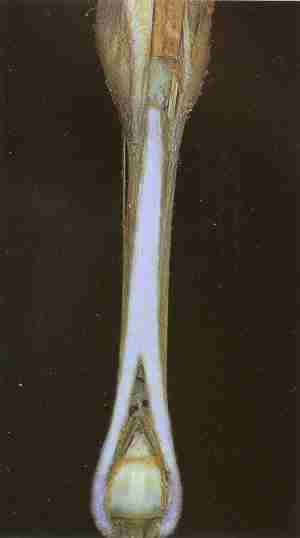Suspensory Desmitis: Strains, Sprains, and Disruption
by Robert N. Oglesby DVM
Introduction
Introduction
»
Anatomy
»
Overview
»
Proximal Suspensory Desmitis: Forelimb
»
Proximal Suspensory Desmitis: Hindlimb
»
Suspensory Body Desmitis
»
Single Branch Desmitis
»
Bilateral Branch Desmitis
»
Disrupted or Torn Suspensory
»
First Aid, Treatment, and Rehabilitation
»
More Info & Discussions
Let's begin by realizing their are two conditions of the suspensory ligament that are often confused, suspensory desmitis and suspensory desmopathy. Desmitis is inflamation of the ligament most often due to trauma. Desmopathy is a degenerative condition of the ligament due to a lack of proper protein structure. This article deals with the inflammatory condition, for more on desmopathy see,
Degenerative Suspensory Ligament Desmopathy / Desmitis (DSLD).
The suspensory ligament and its associated structures, the proximal sesamoid bones, and distal sesmoidean ligaments, are important in helping the flexor tendons support the fetlock in the standing and moving horse. The complexity of the suspensory ligament and its important function of supporting the fetlock makes it a common site of injury, once the foot is ruled out. Inflammatory changes like that caused by strain and sprains of a ligament is known as desmitis. Tearing of the complete ligament is called disruption.

Suspensory ligament "posterior aspect" (blue) with the overlying flexor tendons removed. Originating on the back of the cannon bone, the suspensory divides in two and terminates on the sesamoid bones of the fetlock.
This article discusses the different conditions effecting the suspensory ligament and it's accesory structures, how they are diagnosed and then some discussion on treatments and prognosis based on the specific structure and lesion. A general discussion about various treatments available for treatment of the suspensory are discussed in the
First Aid, Treatment, and Rehabilitation section at the end of the article.
For help understanding the anatomy see
Cannon Anatomical Study.
Anatomy
Introduction
»
Anatomy
»
Overview
»
Proximal Suspensory Desmitis: Forelimb
»
Proximal Suspensory Desmitis: Hindlimb
»
Suspensory Body Desmitis
»
Single Branch Desmitis
»
Bilateral Branch Desmitis
»
Disrupted or Torn Suspensory
»
First Aid, Treatment, and Rehabilitation
»
More Info & Discussions
The suspensory ligament is principally behind the cannon, between the splint bones and deep to the flexor tendons. It begins at the top of the cannon and runs down the cannon where before it gets to the fetlock it splits into two branches which then insert on the top and sides of the sesamoid bones. Continuing off the bottom of the sesamoid bones are the distal sesamoidean ligaments, which continue downward insert on the back of the pastern. Injuries to the distal ligaments are discussed in,
Diseases of the Pastern.
An important connected structure is the inferior check ligament that originates on the back (posterior) of the suspensory ligament near its top and then connects to the front (anterior) of the deep digital flexor tendon about 1/3 of the way down the cannon,
...more.
Injury to the suspensory ligament often accompanies other injuries to supporting structures, including the:
Severity and prognosis are also dependent on the location within the ligament that is strained. The injuries vary tremendously from minor transient lameness problems to severe performance limiting disease. This article discusses the various forms of suspensory strain, their diagnosis, treatment, and prognosis.
Overview
Introduction
»
Anatomy
»
Overview
»
Proximal Suspensory Desmitis: Forelimb
»
Proximal Suspensory Desmitis: Hindlimb
»
Suspensory Body Desmitis
»
Single Branch Desmitis
»
Bilateral Branch Desmitis
»
Disrupted or Torn Suspensory
»
First Aid, Treatment, and Rehabilitation
»
More Info & Discussions
You have just read the beginning of this article. To access the unabridged article
become a Member of Horseadvice.com! Your membership gets you instant access to this and over 600 articles on our site. Other benefits of your membership include participation in our discussion boards and access to our one button PubMed search tool for each topic.
Horseadvice can teach you to be a more knowledgeable horse owner which leads to a healthier horse and save you money. Really, we guarantee it.
Come Join Us!
